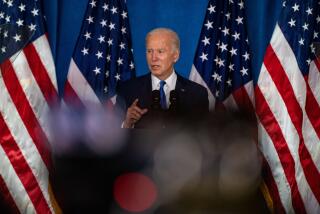McManus: Obama’s Gitmo woes
President Obama sounded genuinely outraged last week when he talked about the Kafkaesque situation at the Guantanamo prison camp, where the United States has been holding 166 men without trial for terms that are, at this point, officially endless.
“It’s not sustainable,” the president thundered. “I mean, the notion that we’re going to continue to keep over 100 individuals in a no man’s land in perpetuity?”
But at least some of Obama’s anger should be directed at himself, because his own silence and passivity on Guantanamo are part of the problem.
EDITORIAL: Erasing the stain of Guantanamo
The president campaigned in 2008 on a pledge to close the camp; once in office, he signed an order to move the prisoners to the United States within a year.
Since then, however, in the face of congressional opposition and political obstacles, he has backed away.
Only now, with a hunger strike among some 100 of the camp’s 166 detainees entering its fourth month, does the president seem to have reengaged.
Obama, of course, blames Congress for making it impossible for him to close Guantanamo. But as with most ugly messes in Washington, there’s plenty of blame to go around.
It’s true that in 2010, Congress blocked the president’s proposal to close the camp and move its inmates to an unused “supermax” prison in Illinois that could have housed them securely (and more cheaply).
But that’s only part of the story. Amazingly, 86 detainees — more than half of those still at Guantanamo — were cleared for release or transfer to other countries more than three years ago. Twenty-eight of those were initially OKd for transfer by the George W. Bush administration in 2007. But all are still in Guantanamo.
Part of the problem, at least initially, was that the detainees’ home countries didn’t all want them back. But a State Department negotiator, Daniel Fried, went to work on that problem and solved most of it. Yemen has agreed to take its 56 of the 86 cleared detainees; Afghanistan has asked for 17 detainees back; even Britain has requested the release of a Saudi citizen whose wife and children are Londoners.
The Obama administration created another part of the problem itself. In 2010, after Al Qaeda put a Nigerian terrorist with a bomb in his underwear aboard a flight to Detroit, the administration suspended all detainee transfers to Yemen, where the plot had been hatched. Since then, Yemen has become more stable and the United States has worked with its government to build a rehabilitation facility for returning detainees, but officials say it isn’t ready yet.
Congress weighed in too. Alarmed by reports that some released detainees had rejoined Al Qaeda or the Taliban, members of Congress demanded a formal assurance from the secretary of Defense that no future parolee would return to the battlefield.
After the administration pointed out that no one could absolutely guarantee that returning detainees would lead virtuous lives — most of them were anti-American extremists when they were apprehended, and their time in Guantanamo is unlikely to have made them friendlier — Congress provided some wiggle room.
Under current law, a detainee can be transferred home if the secretary of Defense, the secretary of State and the director of national intelligence all affirm that the country he’s heading for is taking steps to “substantially mitigate” any danger to the United States.
But that still requires Obama and his aides to take a big political risk every time they decide to release a detainee — and an opportunity for opponents to pounce the next time a Guantanamo alumnus turns out to be a recidivist, as some inevitably will.
As Sen. Lindsey Graham (R-S.C.) said last week, making no distinction between the most dangerous detainees and the least: “They’re individuals hell-bent on our destruction and destroying our way of life.”
Not surprisingly, Obama hasn’t been quick to embrace those risks. But his understandable caution is another reason the 86 detainees who have been cleared for transfer are still in limbo — and, in many cases, on a hunger strike.
There are steps Obama can take. He can appoint a successor to Fried, whose job has been empty since last year, and resume finding new homes for released detainees. Even better, he could appoint a high-level deputy for Guantanamo — Vice President Joe Biden, say, or retiring FBI Director Robert Mueller or even former CIA Director David H. Petraeus — to negotiate a solution with Congress, which has been more trouble than most foreign governments.
And he can begin sending detainees to Yemen and Afghanistan, both of which say they are ready to receive them.
None of those steps alone will result in the closure of Guantanamo. Obama has endorsed indefinite detention for terrorist suspects, at least as long as the war with Al Qaeda persists. Marine Gen. John F. Kelly, the head of Southern Command, says he’s already thinking about upgrading medical facilities to take care of the detainees as they age.
But reducing Guantanamo’s population would solve a big chunk of what has become an apparently insoluble problem. Resuming the transfers, especially for those who have already been offered a ticket out, would offer remaining detainees at least a shred of hope.
Obama and his aides say they are looking at all those remedies now. It’s a shame it took a hunger strike to remind the president of his own convictions.
Follow Doyle McManus on Twitter @DoyleMcManus
More to Read
A cure for the common opinion
Get thought-provoking perspectives with our weekly newsletter.
You may occasionally receive promotional content from the Los Angeles Times.







